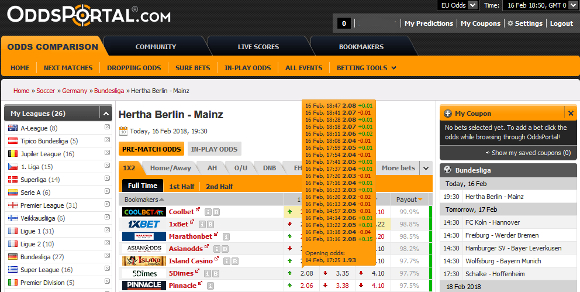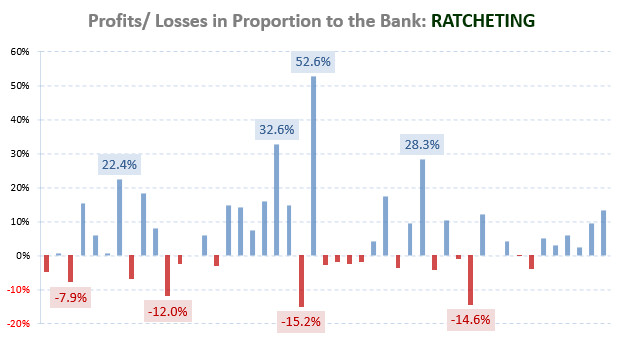
Step 6 – Bet Selection
Okay, so you’ve bought your tables, analysed your leagues, come up with your systems, and adjusted the inflection points using standard deviation technique.
How do you go about choosing which games to bet on?
We are assuming you have experience placing bets and have access to a range of bookmakers and at least one betting exchange, with funds available. If not, then we suggest you read our blog thoroughly before committing money to any betting adventure.
The important thing to understand about the data driving the HDAFU Tables is that the odds are the highest market odds recorded as near as possible to the close of the ante post market.
In the case of 99.9% of all games listed in the Data Tab of each table, the odds shown are the highest available at some point within the final 10 minutes before the market closes and the match goes in-play. In the vast majority of cases, however, the data is time-stamped within one or two minutes before kick-off.
This means that the optimum time to place bets is during the final 10 minutes before kick-off, after the market has reacted to the team news and line-ups.
Using an Odds Comparison Site
We use OddsPortal as our odds benchmark on the day of matches. But like any miner of third party information they rely on API’s to gather data.
Odds have a habit of moving fast, especially near the point of in-play when the biggest wedge of money is being wagered, so some bookmakers’ odds showing on OddsPortal are sometimes unavailable once you visit their sites. The same can be said of all odds comparison sites.
Of course, it is impractical to have a whole bunch of bookmaker sites open at once just to check their prices, but with OddsPortal it is possible to see the time-stamps of the last contact they had with a particular bookmaker to see when those odds were recorded. This is why we use them: because they are the only site that includes time-stamped odds.
Most of the time, you will not have any issues as a result of moving odds because the prices of the particular bet type you are interested in remain comfortably within your two inflection points.
You may even decide to place bets far earlier than close to kick-off time because of this very reason. After all, if the market indicates the match fits your selection criteria, in other words, the highest odds on offer at the time are inside your inflection point parameters, then the bet is still a valid one to place, even if you could have got a higher price still within your range, or the price you obtain turns out to be higher than the closing price.
Shall I, Shan’t I?
The only time you will have more pressing decisions to make is when the price of the result you are looking at in a game you are interested in is close to either one of your inflection points.
For example, let’s look at home wins and favourites. Your lower inflection point is 2.15 and the market is hovering around 2.12. Do you wait and see if the price rises, or perhaps request a higher price again using an exchange (taking commission into consideration)?
What happens if the price is 2.17 and you take the bet at that price, only to see the market fall to 2.12 at kick-off?
The answer is that it really doesn’t matter. Over the course of time, things will even themselves out. You’ll place some bets at prices within your range that later drift outside. Some of these bets will win and some will lose, but the vast majority of your bets will be safely inside your ranges. You’ll also achieve higher prices (and higher rewards) on some bets that settle at lower prices but still inside your range.
Of course, if you place a bet at a price that does then drift (reduce) outside of your lower inflection point, you always have the option of laying it at an exchange at the lower price and achieving arbitrage for a profit before the game even kicks-off.
On higher prices (draws, away wins, underdogs), if the price rises above your upper inflection point, you have the option of laying at an exchange for a small loss before kick-off (which we personally don’t do), or letting it ride. If the result goes your way (i.e. if you’re on the draw and it stays a draw for some time; or if the underdog scores first), you can always lay in-play for a profit or break-even position.
But it’s the higher odds that ultimately earn you the profits when it comes to portfolio betting. Again, some of these outliers will win and some will lose, and you will find that in the end, things will tend to balance themselves out.
Which Bookmakers to Monitor?
OddsPortal is a very easy site to use and navigate.
We have produced a basic guide to everything you need to know about using their site here.
In this article you will also find out which bookmakers we pay particular attention to when deciding upon our own bet placements in conjunction with the HDAFU Tables. You will also be walked through how to set up your OddsPortal account to resemble our own.
Signing-up to OddsPortal places absolutely no obligation on you whatsoever, and you can use it to monitor odds completely free of charge and without the worry of receiving any junk mail from them. (Soccerwidow is not affiliated with OddsPortal in any way, although we are always happy to recommend them).
How do I Find the Time-stamps in OddsPortal?
Open any match you are interested in and simply hover your cursor over the odds of any bookmaker to see their progression.
(Click on the image below to enlarge it in a new tab):

And that’s it really. Of course, the most important goal when placing any bet is to try and achieve the highest price possible.
If you are falling far below the highest price available on a regular basis you may wish to monitor what effect that is likely to have on your results by learning about the HDAFU Tables’ Odds Toggle function. Hopefully, we’ve thought of everything!
Conclusion
The league we have used in this example formed part of our 2017 Summer League portfolio. We don’t see any point updating this article with more recent examples as all the current tables operate in the same manner we have described.
Incidentally, We chose this example completely at random, knowing that every league contains a system of this nature.
Indeed, there are plenty of systems to find where all five of the previous seasons have produced profits.
We demonstrated this in our 2016 Campaign article, which used eight ‘perfect’ systems out of a total of 15 employed.
Here’s the story of that campaign recounting how we made over £10k in 178 days with level stakes of £100, with just a small portfolio of Summer League systems.
The following 2016-17 Winter League Campaign made almost double that amount.
Bookmaker Business Model
The bookmakers cannot cover every angle. The best they can do is make a small commission on every game via overround (vigorish), based on the weight of money staked.
They firstly do not have the time to take a more targeted approach – they process hundreds of thousands of betting opportunities every week.
Secondly, their commission based business model doesn’t give them any scope to do this. In short, they don’t need to do it.
They do not try to predict the outcomes of matches.
They base their odds on historical statistics and adjust them according to the weight of money staked.
HDAFU Table Business Model
What we are doing is targeting the perennial sweet spots in the historical results (the previous five seasons in each league).
To do this we use a combination of the match results and their odds to see where the greatest return in the profit/loss curve was.
We first use a graph to visualise this, and then use the table of data to narrow down our field of view for higher precision marksmanship.
It’s the simplest way we know of building a potentially high yield investment plan, which is driven and protected by the synergy of the many systems running parallel with one another in our portfolio.
And, it’s an active investment throughout the year with both Summer League and Winter League systems overlapping throughout the calendar. (We never have a mid-season break!).
Like our other articles say, you’ll need a portfolio of at least 500 bets in a similar time scale to see the benefits of finely-tuned systems supporting one another.
This means several systems from several leagues to provide the statistical synergy you will need.
If you would like to see the layout of our HDAFU tables before buying them, then here’s that free download button again:
Again, this table is a dummy with all features disabled: Sorry, but you will need to buy a table to access the full benefits.
Okay, that’s pretty much it for this article. Hopefully we have put things more on a plate for you but if there is anything you wish to ask, then please use the comments box below.
However, before you do get in touch with us, read the comments below and also the ones on the Summer League Campaign and the Winter League Campaign articles, as your question will probably already have been addressed. The existing customer comments are a veritable mine of information to further your thinking.
Buy The Current Summer League & Winter League HDAFU Tables Here!
And don’t forget, you get all three tables (whole season, first and second half season) whenever you buy a single league. (Except Australia A-League = Whole Season Analysis Only).
Thanks for reading and happy hunting!








Hi,
When will the 2018-19 winter league tables be available for purchase?
Thanks.
Hi Simon,
our deadline is to publish the tables for the 2018-19 season the next two weeks.